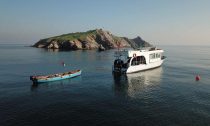
Transplanting coral is difficult work. “You only have 20 minutes to dive down 30 metres and transplant the coral to the correct part of the rock, where hopefully it will live for hundreds of years,” explains Serço Ekşiyan, one of a small group of volunteers who have taken on the huge task of saving the corals around the Princes’ Islands (Adalar), a picturesque archipelago in the Marmara Sea about a 40-minute boat ride from Istanbul.
The Marmara Sea, made up of water from the Black Sea and the Mediterranean, is home to 24 Alcyonacea coral species whose existence is threatened by the onslaught of nearby property development. Among those disappearing are sea whips, sea pens, sea fans and some types of red and yellow soft corals.
“Most of these corals you would never find outside of the Mediterranean basin. The further east you go, the more they move into deeper waters. It’s miraculous that we are able to see them on the shores of the Princes’ Islands,” says Dr Eda Topçu, a marine biologist at Istanbul University and leader of the transplantation project. These corals, she says, are crucial for the survival of marine ecosystems as they provide safe spawning and nursing environments for aquatic life.
Since 2015, the Adalar Marine Life and Sports Club (Adysk), of which Ekşiyan is a member, has been working closely with scientists to revive and protect the marine ecosystems of the northern Marmara Sea, primarily clearing the seabed of ghost nets abandoned by industrial (and sometimes illegal) fishing boats.
When tons of building debris dumped off the coast of Yassıada Island killed a large coral community in late 2015, however, its work increased overnight. Yassıada is a tiny island, less than 1km long, but is now home to a hotel, mosque, conference building and museum. Ekşiyan gets out his phone to show images of the before and after of Yassıada’s underwater habitat: traceries of golden coral reduced to what look like wires covered in thick dust.
In 2017, plans were made to start yet more land development work on another of the Princes’ Islands, Sivri Island, which sits in the centre of a large coral reef. Determined that what happened on Yassıada would not be repeated, the team began the painstaking process of transplanting the corals to a safer location, working closely with marine biologists and Turkey’s Scientific Research Council, Tübitak.
In two years, they transplanted 280 corals to the shores of uninhabited Tavşan Island, eight miles (13km) away. This was the first coral transplant undertaken in Turkey.
“It was a process of trial and error,” Ekşiyan says. “None of us had ever transplanted corals before.” He demonstrates on a nearby wall how the team affixed the coral in a grid at the bottom of a deep sea cliff between existing reefs, using a solvent that had to be prepared in situ, because it turns rock solid almost immediately. Getting his phone out again, he shows pictures of three corals that didn’t make it, stuck in lumps of adhesive before they could be placed on the grid.
Despite the challenges, they achieved an impressive 90% success rate in 2017 when transplanting the first 90 corals, and 60% in 2019 for the remaining 190. Volkan Narcı, the founding member of the group, says the corals are adapting well to the new reef substrate. Now, they just need to be protected.
Every day, new marine species enter the Marmara Sea, migrating from the south. “Many animals, such as octopuses, tortoises, groupers and swordfish are coming from the Mediterranean to the Marmara Sea due to coral bleaching and loss of habitat there – which means the Marmara is turning into a haven for certain ecosystems that we must protect,” says hydrobiologist Dr Cem Dalyan.
“It’s a bit like the Noah’s ark legend – if you preserve a small number of each species, they will multiply and thrive again once the calamity is over. The Marmara Sea is the ark, and could save the entire Mediterranean.”
The Adysk team are currently negotiating with the government to designate the area around Tavşan Island a marine protected area, which would mean no more fishing and a prohibition on boats dropping anchor. The zone would also protect the sea from construction work.
“This is the only way we can make sure the corals are given a chance to develop into a healthy colony,” says Narcı. But their attempts to convince a remote and often unsympathetic Ankara bureaucracy have so far been unsuccessful. They recently launched a petition to get 1,000 signatures in support of the protection zone, which they will then take to the government.
But the future is uncertain. Ekşiyan and Narcı talk about similar European initiatives working to protect marine life, such as Healthy Seas and Ghost Diving, that have access to funding and support from sponsors and government, while Adysk has neither. It is supporting itself independently, through scuba diving classes and freelance jobs, but says it is in dire need of permanent funds and government support.
Narcı emphasises the importance of educating local people, especially young people, about the Marmara Sea and the ecosystems within it. The team are working with local civil society groups on the Princes’ Islands to raise awareness of the science around these specialised habitats and to introduce people to marine life, especially corals.
Narcı says: “So much of our oxygen is produced by plankton photosynthesis, and these plankton live in the shelter of coral colonies. We have to tell everyone about this, or we will all suffocate.”













Social Profiles